
“Process saves us from the poverty of our intention,” said American sculptor Elizabeth King.
This quote resonates with me, particularly at the start of a new year when willpower is strong and intentions clear, but as time wanes on, we all know that if the underlying process or framework isn’t in place, or priorities and habits established, then sustained success is unlikely.
When COVID surged through our communities last year, bringing with it fear and uncertainty, it presented the Department of Conservation a great opportunity to evaluate our processes, check our resolve, and grow our resilience. And as for the public we serve, a common theme emerged from the chaos — people needed the outdoors for their own well-being.
Many Missourians flocked to the outdoors to hike, bike, walk, hunt, fish, camp, or simply enjoy being outside. Bikes and camping gear flew off the shelves at sporting-goods stores. The Missouri Conservation Commission waived requirements for fishing permits to encourage more people to get outdoors, noting the cost of a permit might be a barrier to its citizens.
Hunters and anglers came out in droves to our forests, fields, lakes, and streams. One example — the number of Missouri spring turkey hunters increased 8 percent. During the youth and regular season, hunters harvested 41,461 turkeys, a 7 percent increase from the 2019 total.
This increase in hunting and angling activity was mirrored across the country as well. The Recreational Boating and Fishing Foundation (Unpublished data 2020) documented a 14 percent increase in fishing license sales across the United States.
Though MDC in-person programs were immediately cancelled, the MDC team shifted quickly to make virtual programming a viable option. Our team developed online programs featuring wildflowers, rain gardens, backyard birdwatching, and butterflies. Registrations spiked as hundreds participated in the virtual classes. Many Missourians engaged with MDC online for the very first time. New connections included weekly Facebook Live events with MDC Naturalists promoting outdoor activities anyone could enjoy safely. People seemed to be open, even hungry to acquire new outdoor skills.
While some MDC staff needed to pivot to meet the challenges COVID presented, others stayed focused on the critical conservation work at hand. Processes were in place, priorities clear, our resolve intact. In the next few pages of our annual review, you will see some of the great accomplishments made by MDC staff with the help of our committed partners, despite pandemics, social and political unrest, and uncertain times — all to ensure we are taking care of nature, connecting people with nature, and maintaining the public trust. Together anything is possible.
SARA PARKER PAULEY, DIRECTOR


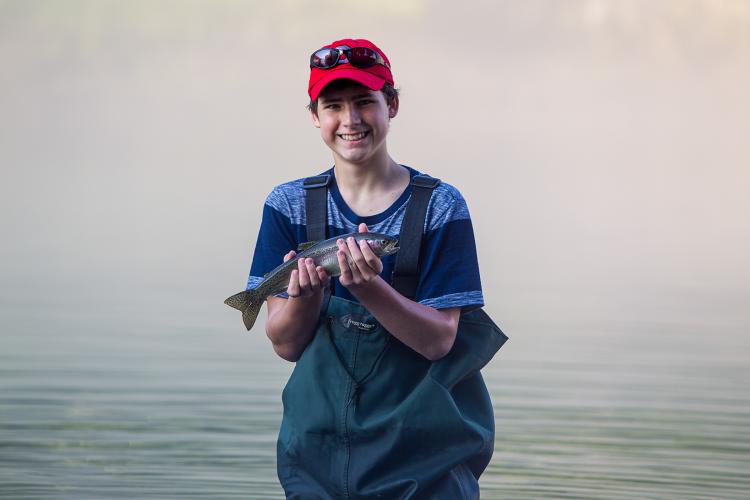

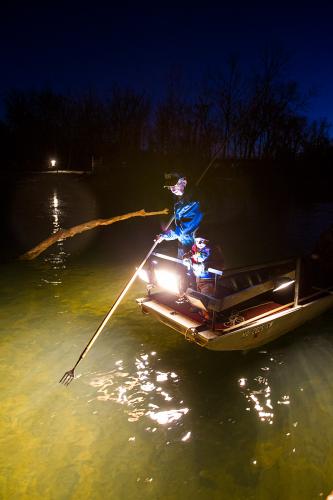
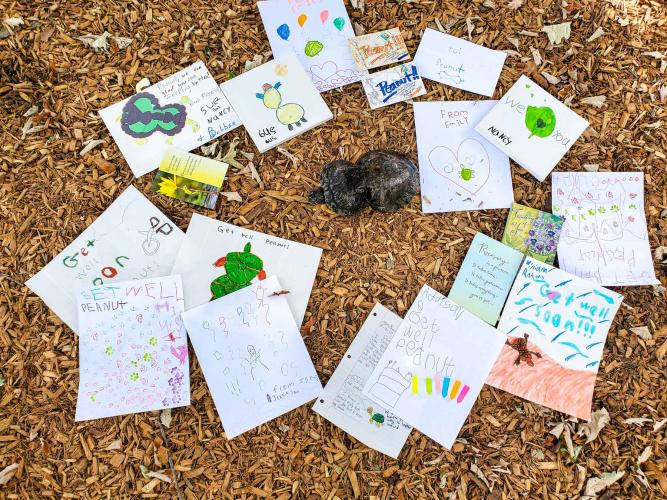

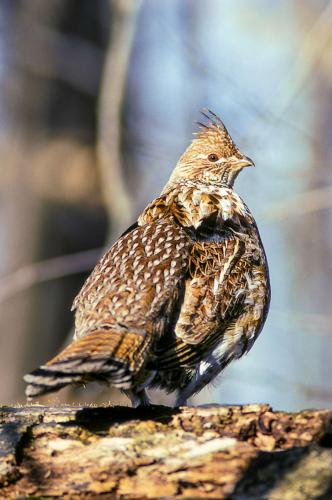

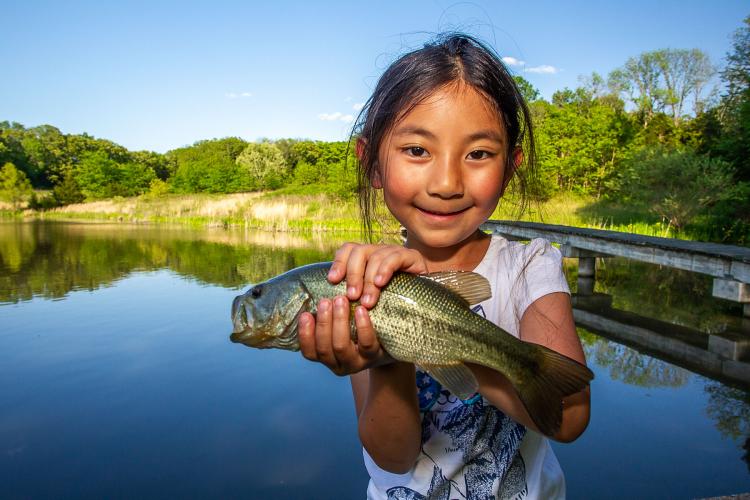

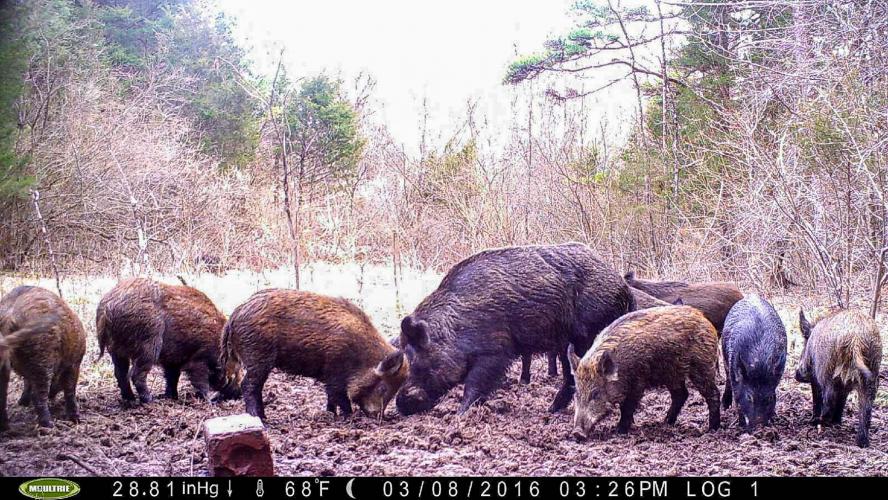




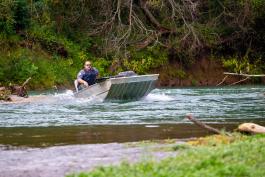








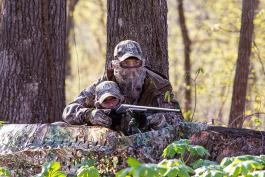
Title
State of Missouri Operating Budget
Total State of Missouri Operating Budget for Fiscal Year 2020
$29,757,795,223
Missouri State Operating Budget
MDC represents less than 1 percent of the total state budget and receives no state general revenue.
MDC Receipts
MDC gets the majority of its funding through the conservation sales tax. For every $8 spent on taxable items, one penny goes to conservation.
Conservation Sales Tax. . . . . . . . . . . $123,010,768
Permit Sales. . . . . . . . . . . . . . . . . . . . . .$34,788,222
Federal Reimbursements. . . . . . . . . .$33,498,035
Sales and Rentals. . . . . . . . . . . . . . . . . . $6,421,073
Other Sources. . . . . . . . . . . . . . . . . . . . . .$3,416,116
Interest. . . . . . . . . . . . . . . . . . . . . . . . . . . $1,537,451 Conservation Sales Tax Permit Sales Federal Reimbursements Sales and Rentals Other Sources Interest
MDC Disbursements
Funds are distributed throughout the divisions to accomplish the top conservation priorities across the state for MDC.
Capital Improvements. . . . . . . . . . . . . . . . . . . . .$29,498,017
Wildlife. . . . . . . . . . . . . . . . . . . . . . . . . . . . . . . . . . $23,462,979
Forestry. . . . . . . . . . . . . . . . . . . . . . . . . . . . . . . . . .$18,636,784
Protection. . . . . . . . . . . . . . . . . . . . . . . . . . . . . . . . $17,410,963
Outreach and Education. . . . . . . . . . . . . . . . . . $16,668,606
Information Technology. . . . . . . . . . . . . . . . . . . .$15,323,652
Fisheries . . . . . . . . . . . . . . . . . . . . . . . . . . . . . . . . .$14,451,221
Design and Development. . . . . . . . . . . . . . . . . . $14,312,116
Resource Science . . . . . . . . . . . . . . . . . . . . . . . . $13,686,282
Administrative Services. . . . . . . . . . . . . . . . . . . .$10,529,440
Private Land Services. . . . . . . . . . . . . . . . . . . . . . .$9,618,308
Administration. . . . . . . . . . . . . . . . . . . . . . . . . . . . $4,088,499
County Assistance Payments. . . . . . . . . . . . . . . .$2,686,946
Human Resources. . . . . . . . . . . . . . . . . . . . . . . . . $2,546,570
Regional Public Contact Offices. . . . . . . . . . . . . .$2,214,489
NOTE: Disbursements include all operating, other agency, and capital improvements from the Conservation Commission Fund. Other agency disbursements are appropriated outside the Department of Conservation operating budget. Fuel, benefits, and other disbursements were allocated to the appropriate divisions.
SOURCE: Missouri Office of Administration Government Services Transportation Conservation Natural & Economic Resources Education Health and Social Services 46.0% 25.6% 15.1% 9.7% 3.0% 0.6%
Title
MDC Takes Care of Nature
We protect and manage Missouri’s fish, forests, and wildlife, so you can enjoy healthy and sustainable resources now and in the future.
Youth Pollinator Event
More than 40 children and their families attended the Youth Pollinator Event on Feb. 29, 2020. Hosted by MDC, Mid-Mo Uplanders Quail Forever Chapter, and A.L. Gustin Golf Course in Columbia, the event introduced children to pollinators, such as butterflies, and the important role they play in the environment. The children also spread native seed on a half-acre tract of property on the golf course.
Over the past 20 years, the staff at A.L. Gustin Golf Course has worked to enhance natural communities on the course — restoring habitat for wildlife and pollinators. This work has made A.L. Gustin the first university golf course in the country to achieve full certification in water conservation, environmental planning, outreach and education, water quality management, integrated pest management, and wildlife and habitat management.
Monitoring
The Missourians for Monarchs and Pollinators Collaborative was formed in 2016 and has over 45 partners working to restore pollinator habitat in Missouri. They set a goal of 385,000 acres of habitat that would benefit monarch butterflies. This goal has been exceeded with over 448,000 acres of habitat reported restored. The acreage comes primarily from MDC conservation areas and private land cost-share programs. The collaborative is acquiring drone technology that will save volunteers thousands of hours in determining if enough milkweed is present in these areas to impact monarch populations.
Grouse Restoration
Ruffed grouse (Bonasa umbellus) were once present throughout most of the state; however, by the early 1900s, habitat loss and market hunting resulted in their decline. After many years of intensive habitat management efforts on Daniel Boone Conservation Area (CA), Little Lost Creek CA, and private lands in the area, MDC developed a plan to restore grouse populations in the River Hills Region of east-central Missouri.
In August and September of 2018, 100 ruffed grouse from northern Wisconsin were trapped and relocated to Little Lost Creek CA. An additional 100 grouse were relocated to Daniel Boone CA in 2019. To monitor the success of the restoration effort, MDC researchers have begun listening for the birds’ drumming wings, known as grouse drumming surveys. These are conducted annually.
In April 2020, staff conducted drumming surveys on both Little Lost Creek and Daniel Boone conservation areas. Staff detected seven drumming grouse and flushed an additional three grouse. In addition to the grouse detected during the surveys, several private landowners in the area have reported grouse sightings on their properties, which shows early success for this restoration effort.
Due to the COVID-19 pandemic, MDC and the Wisconsin Department of Natural Resources agreed to delay the last year of the grouse relocation until August and September 2021. Habitat work on the conservation areas and nearby on private properties continues.
Record Fish
Missouri is a great place to fish. Just ask Bryant Rackers, who broke four state records in one year. He contributed to 14 record-breaking catches in FY20. Seven of the records were caught by pole and line, and seven were taken by alternative methods.
- Mitchell Dering, Wappapello, caught a 6-pound, 2-ounce spotted gar measuring 34½ inches by pole and line in the St. Francis River in Wayne County.
- Cody Sparkman, Perryville, hooked a 2-pound, 13-ounce black bullhead measuring 16 inches by jug line at a private pond in Perry County.
- Bill Babler, Blue Eye, caught a 40-pound, 6-ounce brown trout measuring 41¼ inches from Lake Taneycomo in Taney County.
- Jacob Morgan, Rogersville, caught a 2-pound, 13-ounce gizzard shad measuring 194/5 inches from Bull Creek in Taney County.
- Bryant Rackers, Bonnots Mill, hooked a 3-pound skipjack herring measuring 205/8 inches from the Osage River in Osage County.
- Bryant Rackers, Bonnots Mill, caught a 10-ounce white perch measuring 105/16 inches from the Osage River in Osage County.
- Bryant Rackers, Bonnots Mill, caught a 2-pound, 1-ounce sauger measuring 171/8 inches from the Osage River in Osage County.
- Tyler Halley, Maryville, hooked a 1-pound, 14-ounce yellow perch measuring 147/8 inches from a private pond in Nodaway County.
- Brian Holiday, Fordland, caught a 2-pound, 3-ounce yellow perch measuring 149/10 inches from Bull Shoals Lake in Taney County.
- Bryant Rackers, Bonnots Mill, caught a 2-pound, 6-ounce shorthead redhorse measuring 18½ inches from the Osage River in Osage County.
- Justin Lakey, Ava, caught a 5-pound, 1-ounce white sucker measuring 23 inches from Lake Taneycomo in Taney County.
- Joseph Duncan, Fredericktown, caught a 3-pound, 9-ounce gizzard shad from a private pond in Madison County.
- John Garver, Williamsville, caught a 3-pound, 6-ounce spotted sucker from Duck Creek CA in Stoddard County.
- Tyler Goodale, Poplar Bluff, hooked a 5-pound, 4-ounce spotted sucker from Duck Creek CA in Stoddard County.
Turkey Management Plan
MDC is revising the Missouri Wild Turkey Management Plan. As part of the process, MDC hosted a partner meeting May 18, 2020. Due to COVID-19, eight partners from a variety of agencies and nongovernmental organizations met online and provided input on the plan. Public input was collected on the revised Wild Turkey Management Plan from June 1–July 1, 2020. Almost 700 people provided comments via the online questionnaire, while some were received through handwritten letters, emails, and the Wildlife Health comment box. Comments were received from eight states in addition to Missouri. For more information about the state’s Wild Turkey Management Plan, visit short.mdc.mo.gov/Z2W.
Due to COVID-19, Powder Valley Conservation Nature Center was closed, but that didn’t stop Peanut’s fans from sending love. Peanut was flooded with cards and well-wishes.
Peanut Recovers from Surgery
Peanut the turtle returned to Powder Valley Conservation Nature Center in Kirkwood after undergoing surgery at the St. Louis Zoo May 4. Due to a condition known as follicular stasis, Peanut had to have both of her ovaries surgically removed. The condition prevented her from eating properly and stressed her other organs, like the liver and lungs.
The 36-year-old Peanut has attracted attention all over Missouri, along with national and worldwide fame, as an anti-littering mascot. At a young age, the red-eared slider wandered into a plastic six-pack ring and it stuck around her shell. As her shell grew, it was constricted by the plastic ring and developed an unusual, figure-eight shape. In 1993, when she was about nine years old, someone found her and brought her to the St. Louis Zoo where the ring was removed.
They named her Peanut because of her shell’s shape and gave her to staff at MDC. Peanut has been under the care of MDC since then, where she has served as a popular ambassador for litter awareness.
Poaching Penalties Increase
On July 11, 2019, Missouri Gov. Mike Parson signed HB260. Called the Poaching Bill, it significantly raised fines for those convicted of illegally taking Missouri game species and other native wildlife. HB260 was sponsored by Representative Jered Taylor (Republic) and Senator Mike Bernskoetter (Jefferson City).
New fine amounts include $10,000–$15,000 for each elk or black bear killed illegally, $1,000–$5,000 for each white-tailed buck, $500–$1,000 for each wild turkey, and $500–$1,000 for each paddlefish.
The fines are considered restitution payments for poaching game animals and are ordered by a judge. Monies from the fines go to the state’s school monies fund. The restitution payments are in addition to other fines and penalties for violating the Wildlife Code of Missouri. The new fines went into effect Aug. 28, 2019. MDC and the Missouri Conservation Commission also increased the penalty points given to individuals convicted of violating the Wildlife Code of Missouri for illegal activities, including poaching.
According to MDC records, 547 wild turkeys, 58 paddlefish, and 4,731 deer were illegally taken, or poached, in 2017 and 2018. MDC is also investigating the poaching of five elk over the past several years. Black bear poaching incidents are a growing concern as well.
Arrests in Walnut Timber Theft
An investigation into walnut timber theft in southwest Missouri resulted in multiple felony and misdemeanor charges against eight suspects in July 2019. MDC conservation agents began the investigation in early 2018, working with sheriff’s departments in Benton, Cedar, Henry, St. Clair, and Vernon counties, the El Dorado Springs Police Department, the U.S. Army Corps of Engineers, and other MDC staff.
According to MDC Protection Captain Joni Bledsoe, walnut timber with an overall saw log value of $61,804 was taken off public lands in Henry, Benton, St. Clair, and Vernon counties. Bledsoe noted the trees also had a scenic value to people, and a food and habitat value for wildlife. In addition to the thefts from public lands managed by MDC and the Corps of Engineers, thefts from private lands, including property owned by the Nature Conservancy, were reported.
MDC asks the public to be on alert for illegal timber theft and report any suspicious activity to the Operation Game Thief hotline at 1-800-392-1111. For information about the Operation Game Thief hotline, visit short.mdc.mo.gov/ZoB.
Poaching Arrest
Throughout October 2019, conservation agents working the area near the Lake of the Ozarks responded to multiple complaints of dead deer with only the heads, tenderloins, and other parts removed. A call to the Operation Game Thief hotline ultimately led investigators to a suspect in the Tuscumbia area who now faces charges in Miller and Shannon counties.
Harold P. Piatt, 23, was charged with 14 misdemeanors for the illegal take of deer with the aid of artificial light and the take of deer during closed season, two misdemeanors for the illegal possession of wildlife parts, one misdemeanor charge for taking furbearers in closed season, as well as both misdemeanor and felony drug possession, and drug paraphernalia charges. Each wildlife misdemeanor charge comes with a potential fine of as much as $2,000 and/or one year in jail. With the recent passage and signing of Missouri House Bill 260 by Gov. Parson, authorities may also seek restitution of $1,000–$5,000 for each antlered deer, with all associated monetary penalties going to public schools in the counties where the violations occurred. The firearms, including a .30-06 rifle, a .243 rifle, and a .22 rifle, suspected of being used to commit the violations, were also seized.
Dove Hunting, Nontoxic Shot
MDC required nontoxic shot on many public conservation areas starting in 2019. Waterfowl hunters have used nontoxic shot since 1991 because the requirement has been shown to reduce the incidences of lead poisoning in wildlife. New regulations approved by the Missouri Conservation Commission added more conservation areas to the requirement.
The use or possession of lead shot was prohibited for dove hunting at 20 MDC conservation areas. In addition, the use or possession of lead shot was prohibited for all hunting with shotguns for all wildlife species on several conservation areas. These are conservation areas that are flood prone.
For more information about MDC’s new nontoxic shot regulations, visit short.mdc.mo.gov/Zgt.
Chronic Wasting Disease
During opening weekend of the firearms deer season, Nov. 16 and 17, 2019, MDC set up mandatory chronic wasting disease (CWD) sampling stations in 29 counties, known as the CWD Management Zone. Hunters were required to take their harvested deer (or the head with at least 6 inches of neck attached) on the day of harvest to one of MDC’s numerous CWD sampling stations throughout the zone.
In addition to opening weekend, MDC offered free voluntary CWD sampling and testing of deer harvested anywhere in Missouri throughout the entire deer hunting season at MDC regional offices during regular business hours and through participating taxidermists and meat processors within the CWD Management Zone.
CWD is a deadly, infectious disease in white-tailed deer and other members of the deer family that eventually kills all animals it infects. MDC has found 162 cases of CWD in Missouri since 2012 out of more than 137,000 deer sampled, so the disease remains relatively rare in the state. Learn more at mdc.mo.gov/cwd under “CWD in Missouri.”
MDC Passes New Rules for Transportation and Disposal of Deer Carcasses for 2020
As part of its ongoing efforts to slow the spread of CWD, MDC added regulations to the Wildlife Code of Missouri regarding the transport of deer carcasses and carcass parts into and within Missouri and the disposal of carcass parts for meat processors and taxidermists. The changes became effective Feb. 29, 2020, and were reflected in the 2020 deer season.
The new regulations:
- Restrict transportation of whole cervid carcasses into the state
- Allow for the importation of cervid heads with attached capes into Missouri if they are taken to a licensed taxidermist within 48 hours of entry
- Limit the transportation of whole cervid carcasses out of the county of harvest within the CWD Management Zone, except those being transported to a permitted taxidermist or meat processor within 48 hours
- Allow the transportation of low-risk carcass parts out of the county of harvest within the CWD Management Zone, which includes meat that is cut and wrapped or boned out, quarters without the spinal column attached, antlers, cleaned hides (with all excess tissue removed), antlers attached to skull plates or cleaned skills, and finished taxidermy products
- Require meat processors and taxidermists to discard cervid carcass remains in a properly permitted landfill or waste transfer station; and
- Require that meat processors and taxidermists keep records of cervid carcass disposal.
Full regulations are available in the Wildlife Code of Missouri and the 2020 Fall Deer & Turkey Hunting Regulations and Information booklet, available where permits are sold and online at short.mdc.mo.gov/ZZf.
Feral Hogs on Public Land
In December 2019, the U.S. Forest Service (USFS) announced its decision to prohibit feral hog hunting on public land in the Mark Twain National Forest (MTNF). While prohibiting hog hunting, the USFS decision allows for the “opportunistic take” of feral hogs in the MTNF during all deer and turkey hunting seasons, effective beginning with the 2019–2020 seasons. With the USFS announcement, the Missouri Feral Hog Elimination Partnership developed an operational plan to provide additional staff and resources on private and public land around MTNF. The Conservation Commission is providing $1.8 million annually to the U.S. Department of Agriculture for trapping services, and MDC staff contribute more than 25,000 hours annually towards feral hog elimination on private and public land. Other agencies are contributing staff and resources and will be stepping up their fight against feral hogs. The new plan will reassign staff from across the state to help with feral hog removal in southern Missouri. For information about MDC efforts to eliminate feral hogs, go to mdc.mo.gov/feralhog.
Following the USFS announcement, the Conservation Commission approved identical regulations to ensure consistency regarding opportunistic take of feral hogs during all deer and turkey hunting seasons on USFS and MDC managed lands.
Feral hogs became established in southern Missouri after being released for hunting. Between natural reproduction and continued illegal releases, the feral hog population exploded in southern Missouri and has spread to more than 30 Missouri counties. Recreational hunting of feral hogs complicates efforts to trap and eliminate them. Hunting activities, particularly hunting with dogs, scatters the sounder and makes hogs trap-shy and wary of baited sites, which makes trapping efforts aimed at catching the entire group very difficult. This pattern has been repeated in several states where the combination of recreational hunting and trapping programs has resulted in a larger feral hog population. Examples from other states and from large areas of private land in Missouri show that allowing state and federal wildlife managers to eliminate feral hogs yields the best results.
A group of 10 hogs can destroy 10 to 20 acres overnight, including crops, causing financial burdens on Missouri’s landowners and agricultural producers.
Feral hogs are known to carry diseases such as swine brucellosis, pseudorabies, trichinosis, porcine reproductive and respiratory syndrome, and leptospirosis. The reintroduction of these diseases into the domestic hog population would be devastating to the agriculture industry.
Feral hogs spend a lot of time rooting and wallowing, behaviors that contribute to soil erosion, reduce water quality, and damage agricultural crops and hay fields, as well as destroy sensitive natural areas such as glades, fens, and springs. Feral hogs will eat nearly anything they encounter, including deer fawns and turkey nests. They compete directly with native wildlife by eating acorns, a major fall food source for deer, turkey, and black bear.
Missouri Increases Feral Hog Elimination Efforts, Adapts Strategy for 2020
In 2019, the Missouri Feral Hog Elimination Partnership eliminated 10,495 feral hogs from Missouri, and increased those efforts in 2020. Some of the partnership members participating in on-the-ground trapping efforts include MDC, the U.S. Forest Service, USDA APHIS Wildlife Services, and the L-A-D Foundation.
Increased efforts included a workforce focused on feral hog elimination in key areas, including Mark Twain National Forest lands, beginning in late January. The partnership established a unified incident command structure to manage the effort efficiently and effectively. This structure allowed staff from across the partnership organizations to work more efficiently together.
The partnership’s mission is to eliminate feral hogs in Missouri by implementing the Statewide Strategic Plan for Feral Hog Elimination. This is a strategic incremental approach, clearing each watershed inhabited by feral hogs one at a time.
Beginning in 2016, agencies involved in the partnership significantly increased feral swine removal efforts and put in place hunting prohibitions consistent with the hog elimination plan. This has resulted in the total elimination of feral swine from 116 watersheds totaling over 2.7 million acres previously occupied by feral hogs.
Efforts on private land are only in partnership with the landowner. Landowners receive assistance from MDC and USDA employees to trap and remove the feral hogs. Success is measured in acres covered by staff, number of hogs removed, number of landowners assisted, and watersheds cleared of hogs.
The strategy is to pinpoint the location of a sounder and remove the entire sounder, keep feral hog numbers from increasing in the heart of the population and stop the spread of feral hogs into new areas. Technicians will strategically remove feral hogs along the perimeter of the known hog population, shrinking it until the hogs are eliminated.
Trapping feral hogs takes place year round. Effort is increased during the summer and winter months when food is either scarce or when hogs are around water sources and wallows. These are times of the year when trappers see even greater success.
Monitoring for new populations or releases of hogs to re-establish populations, is another key component of eliminating feral hogs. Genetic testing completed by USDA, APHIS Wildlife Services’ National Feral Swine Genetic Archive team, has identified 14 distinct genetic populations of feral hogs in Missouri. Their work has shown that one out of every eight hogs tested in Missouri comes from a genetic source outside Missouri. Trappers frequently encounter hogs that indicate they have been released, such as castrated boars, one or both ears removed, ear notches, and holes in ears, indicating the previous presence of an ear tag. Trappers have also seen an increase in domestic breed hogs that have been released.
Report feral hog sightings or damage, and learn more about feral hog elimination at mdc.mo.gov/feralhogs. Sign up to receive updates from the Missouri Feral Hog Elimination Partnership at short.mdc.mo.gov/ZoP.
MDC Oversees Return of Elk Hunting
In October and December 2020, MDC oversaw the state’s first-ever regulated elk hunting season. MDC received 19,182 Resident Antlered Elk Applications and 33 Resident Landowner Antlered Elk Applications. From those applicants, MDC issued five permits for the inaugural season — four to members of the public and one to a qualifying landowner in MDC’s elk hunting zone.
The return of elk hunting came after years of restoration efforts of the native species by MDC, numerous partners, including the Rocky Mountain Elk Foundation, and many supporters, including local communities and landowners.
For this first elk season, MDC designated a nine-day archery portion that ran Oct. 17–25 and a nine-day firearms portion that ran Dec. 12–20. The five permits were for bull elk and valid for both portions. All permits were assigned through a random-lottery drawing.
Learn more about elk restoration in Missouri at short.mdc.mo.gov/ZYJ.
Changes to Coyote Hunting, Invasive Species Control
The Missouri Conservation Commission approved regulation changes to the Wildlife Code of Missouri regarding coyote hunting and feral hog control. In response to citizen requests, MDC presented the proposed changes, which included the use of night vision, infrared or thermal imagery equipment, or artificial light to hunt coyotes from Feb. 1–Mar. 31. In addition, the changes allow for landowners or their representatives to use night vision and infrared or thermal imagery equipment without approval from a conservation agent to address damage-causing feral hogs. MDC received public comment on the proposed changes through July 31, 2020. For more information on nuisance and problem species, visit the MDC website at short.mdc.mo.gov/Z5L.
Tiger and Lily Celebrate Birthday
Tiger and Lily, the two-headed western ratsnake that is on display at MDC’s Shepherd of the Hills Conservation Center, celebrated her second birthday in October 2019. The snake, a female that was found in Stone County in the fall of 2017, has grown quite a bit and is about 2 feet in length.
A polycephalous — or two-headed animal — would be extremely vulnerable to predation in the wild. A two-headed snake wouldn’t have the ability to escape into the holes and crevices that normal snakes can fit into. In a captive situation, however, a two-headed snake’s chances of surviving are improved. A two-headed western ratsnake that was found in 2005 is on display at the Missouri Department of Conservation’s Cape Girardeau Conservation Nature Center.
MDC, Partners Seek Help Reversing Bird Decline
A recent study from prominent bird researchers in the U.S. and Canada, including Cornell Lab of Ornithology, found that North America has lost nearly 3 billion birds in the last 50 years, and those declines are also occurring in Missouri.
Over the past year, MDC has been working with the U.S. Forest Service, regional bird conservation group Joint Ventures, Missouri River Bird Observatory, and other land-management agencies and organizations to develop the Missouri Bird Conservation Plan. The plan was created to help reverse dwindling bird populations by focusing statewide conservation efforts across agencies and organizations toward shared goals.
The Missouri Bird Conservation Plan outlines the state’s most threatened bird species and their level of statewide concern, their land management needs, and threats to the species and their habitats. With this information, land management agencies and organizations and property owners can work together to enhance breeding habitats for these priority bird species.
For more information on the Missouri Bird Conservation Plan, bird species at risk, and land management needs, visit short.mdc.mo.gov/ZAF.
There are roughly 335 bird species that commonly occur in Missouri. Of that number, 29 are included in the Missouri Bird Conservation Plan. The list includes the eastern meadowlark, prairie warbler, northern bobwhite, eastern whip-poor-will, and red-headed woodpecker.
How to Help
- Plant natives
- Use window stickers to reduce collisions
- Be a citizen scientist
For citizen scientist opportunities, visit:
- greatmissouribirdingtrail.com
- eBird: ebird.org/science/status-and-trends
- National Audubon Christmas Bird Count: audubon.org/conservation/ science/christmas-bird-count
- US Geological Survey’s Breeding Bird Survey: pwrc.usgs.gov/bbs
- Other citizen bird science efforts: birds.cornell.edu/citizenscience/about-the-projects
- Three Billion Birds Gone: 3billionbirds.org
Title
Flooding Impacts
Dove Season at Columbia Bottom
Due to damaging spring flooding in 2019, MDC changed normal dove hunting procedures at Columbia Bottom CA in Spanish Lake prior to the season’s 2019 statewide opening on Sept. 1. Columbia Bottom spent most of the spring and summer under water due to near-record flooding, so MDC staff were unable to perform normal dove management, including planting sunflower fields.
Once the flood waters receded, extensive silt and mud were left throughout the area. Columbia Bottom staff reported very few doves using the area. In many portions, the deposits were 4 feet high, nearly or completely burying facilities like roads, parking lots and privies, and effectively changing the area’s entire landscape. Dove hunting was permitted but limited to after 1 p.m. during the first seven days of the dove hunting season and during legal shooting hours for the remainder of the season. No managed dove hunts on the area were held.
Schell-Osage: Project Delays
Renovations at Schell-Osage CA were delayed due to major spring and summer flooding in 2019 along the Osage River.
The renovations improve Schell Lake and water control structures, such as levees and a water pump for wetlands adjacent to the lake. The project improves fishing in the lake and provide better wetland habitat for a range of wetland species, including waterfowl and shorebirds.
The area was closed to waterfowl hunting during the 2018–2019 seasons so the project could begin. Schell Lake and wetlands were drained. But severe flooding, starting October 2018 and persisting through August 2019 in the Osage River basin, delayed construction work. Some opportunistic waterfowl hunting was available at waterfowl hunting zones through self-registration at area headquarters during the 2019–2020 duck season, but there was no morning draw for hunting positions.
Renovations at Schell-Osage CA will move forward with help from a $1 million match grant from the federal North American Wetlands Conservation Act. MDC and Ducks Unlimited will use the grant to match the $3.5 million that has been dedicated from a diverse group of conservation partners to make the area better for waterfowl, wildlife watchers, hunters, and anglers.
The public can follow plans and work progress online at short.mdc. mo.gov/Z5C.
Northwest Missouri
Flooding affected fall and winter waterfowl hunting opportunities during the 2019–2020 season in northwest Missouri, along the Missouri River bottoms.
At Bob Brown CA, near Forest City, Missouri River levees were breached. The morning draw system for hunting positions was canceled, but hunters could self-register near the entrance.
Most of the other conservation areas along the Missouri River in Atchison and Holt counties were essentially unavailable to hunters because flood damage to public roads and bridges in the river bottoms prevented access.
Title
MDC Connects People with Nature
MDC Connects People with Nature
We provide places for you to enjoy nature and opportunities for you to learn about and discover nature.
Folks Flock to the Outdoors
While COVID-19 closed many businesses and other work sites last spring — including MDC offices, nature centers, shooting ranges, and other facilities — nature remained open. Many Missourians took advantage of the outdoor offerings to hike, bike, walk, hunt, fish, and simply enjoy being outside on MDC’s many conservation areas around the state.
To help folks get a reprieve from being homebound, the Conservation Commission waived requirements for fishing permits from late March through mid-April and people took advantage of it in droves. MDC’s statewide Free Fishing Days June 6 and 7 also prompted anglers around the state to get outside and cast a line.
While MDC in-person programs were cancelled for several months, the department developed and offered numerous online virtual programs and events on a wide variety of topics from hunting and fishing, to wildflowers, rain gardens, stream life, butterflies, and more.
MDC hunting seasons continued through the closures with spring turkey hunters harvesting 41,454 birds, 2,659 more than in spring 2019. About 9,600 more spring turkey hunters — mostly Missouri residents — bought permits last spring compared to spring 2019.
Throughout it all, MDC reminded the public that it is critical to continue to heed all recommendations regarding public health during outdoor activities in the time of COVID-19.
Record Number of New Turkey Hunters
Missouri turkey hunters, in both the youth and regular seasons, harvested 41,461 turkeys in 2020, a 7 percent increase from the 2019 harvest total. The increase is likely due to an increase in hunter participation. There were 133,022 unique turkey hunters during the 2020 season, an increase of 8 percent from the 2019 season. Resident and youth permit sales were up by 25 and 24 percent respectively from 2019; however, there were 17 percent fewer nonresident permits sold in 2020 than in 2019. Due to the COVID-19 pandemic, which resulted in school closures, work layoffs, and the cancellation of extracurricular activities, it is possible hunters had more time to participate in turkey season this year.
The following are turkey permit sales from the past five years. The numbers provided are unique turkey hunters for each year.
2020. . . . . . . . . . . . . . . . . . . . . .133,022
2019 . . . . . . . . . . . . . . . . . . . . . .123,380
2018. . . . . . . . . . . . . . . . . . . . . .129,820
2017 . . . . . . . . . . . . . . . . . . . . . .137,046
App Usage
In FY20, MDC’s MO Hunting app proved to be the most popular method for checking in harvested deer and turkey. Hunters used the app to check in 167,662 deer and turkey (138,854 deer, 28,808 turkey). The app accounted for 51 percent of checked harvests, while the phone checks accounted for 37 percent, and the remaining 12 percent were completed online. Hunters used their mobile devices to buy 994,274 permits in FY20, an increase of 242,196 from FY19, for a total of $13.3 million sold via mobile devices.
Get the free MO Hunting app for Android or iPhone platforms at short.mdc.mo.gov/Zi2. 20% 0% 2014 2015 2016 2017 2018 2019 2020 40% 60% 80% Mobile Phone Web
Closures
To protect the public amid ongoing COVID-19 concerns, MDC closed nature centers, visitor centers, and education centers around the state to visitors in March 2020.
Despite the closures, all conservation areas, area trails, and boat accesses remained open to the public. MDC offices and shooting ranges also remained open under normal operating hours. Hunting, fishing, and trapping seasons continued as scheduled, as did managed hunts and mentored spring turkey hunts.
To connect people with nature during the pandemic, MDC offered more of its nature-focused programs through online formats. Online offerings made it more convenient and comfortable for people to attend the programs virtually from wherever they were in the state — and beyond. And MDC reached a whole new audience through this venue. In fact, 50 percent of attendees were first-time participants in MDC programs.
MoNASP State Tournament Canceled
With an increasing number of schools closing throughout Missouri due to COVID-19, MDC and the Missouri Conservation Heritage Foundation canceled the annual Missouri National Archery in the Schools tournament. Scheduled for March 19-21, 2020, at the Branson Convention Center in Branson, the event was expected to attract thousands of student archers and their families.
Automatic Permit Renewal
Renewing Missouri hunting, fishing, and trapping permits is easier and more convenient through MDC’s online Permit Autorenewal service. Autorenewal allows online permit buyers to automatically renew their permits prior to the start of the next season or permit year so they always have a valid permit when they need it.
More than 24,200 permits, valued at nearly $670,000, were renewed in FY20 using Permit Autorenewal.
Permit buyers can enroll in Autorenewal at mdc.mo.gov/buypermits during an online permit purchase or by using the “Manage Your Account” feature. Learn more about Permit Autorenewal at short.mdc.mo.gov/ZfF.
Tower Grove Partnership
MDC partnered with Tower Grove Park in St. Louis to bring more nature and outdoor-based educational programing to urban communities. The educational programs in Tower Grove Park expanded on what MDC offers in other St. Louis City parks.
Established in 1868, the 289-acre Tower Grove Park is the second largest park in the city. The park features 7,000 trees of some 300 varieties. The National Audubon Society has designated Tower Grove Park’s Gaddy Wild Bird Garden an Important Bird Area, boasting over 200 documented species. The park hosts approximately 2.5 million visitors each year.
Shoal Creek Conservation Education Center Opens
Shoal Creek Conservation Education Center (CEC), 201 W. Riviera Drive, Joplin, celebrated the facility’s re-opening with an open house on Sept. 6, 2019.
Shoal Creek CEC offers visitors a variety of programs taught by interpretive staff in the facility’s classroom and on the 33 acres that surround the building.
Originally opened in 2007 as Wildcat Glades Conservation & Audubon Center, the facility operated as a joint venture of the National Audubon Society, MDC, and the City of Joplin under Audubon’s management. In November 2017, Audubon announced it was pulling out of the facility and MDC took full ownership of the building on July 1, 2018.
Missouri’s Champion Trees
The hunt for Missouri’s biggest trees resulted in seven new trees being certified as champions this year. MDC’s champion tree program tracks the largest known trees in the state, with over 100 species on the list. How big is big? We measure the height, crown spread, and trunk circumference to calculate champions. This year’s giants range from an American sycamore standing 96 feet tall to a 67-foot-tall sand hickory. The new southern red oak champion has a trunk circumference of 22 feet and a crown spread that’s 80 feet wide. Any tree native to Missouri can be the next champion — check out the current champions at short.mdc.mo.gov/Z4i.
Fish Gigging Season Extended
MDC extended the 2019–2020 fish gigging season by 15 days. The season ran from Sept. 15, 2019–Feb. 15, 2020.
The decision was based on public feedback received through an online survey.
Gigging involves spearing fish using a long forklike spear, or gig, rather than catching them with a hook and line. It is primarily a nighttime activity and is most effective in shallow, clear water.
For more information on fish gigging, visit short.mdc.mo.gov/Z4f.
MDC Opens New Range in Johnson County
MDC hosted a grand opening for a new target shooting range at the Ralph and Martha Perry Memorial Conservation Area in Johnson County on Oct. 9, 2019. It replaced an older range on the area that will now be designated as special-use only.
The new range accommodates both pistol and rifle target practice. The range has four 25-yard lanes, three 50-yard lanes, and two 100-yard lanes. Safety features include a covered firing line, enhanced backstops, and side berms. A 20-foot tall earthen berm will be behind the targets. The range is in an excavated area.
The range is located north of Knob Noster. For more information about MDC shooting ranges, visit short.mdc.mo.gov/ZZF.
MDC Celebrates 75th Anniversary of Missouri’s Modern Hunting Tradition
Missouri reached a major milestone in the fall of 2019 — the 75th anniversary of white-tailed deer hunting. The herbivores are a keystone species that help shape the state’s natural areas. But it took conservation awareness and support by Missourians to restore a creature and its supporting habitats from pioneer-era excesses. Deer populations had dwindled to small herds in the Ozarks until the voter-approved and newly formed Missouri Conservation Commission closed deer hunting in 1937. The policy-setting commission gave MDC the job of restoring deer in the state with science-based research and management. Today, almost a half million deer hunters go afield annually, harvesting almost 300,000 deer and pumping a billion dollars into the state’s economy.
Deer hunters also help MDC maintain an ecological balance for a wildlife species highly valued by Missourians. Deer can over-browse food sources and face heightened disease threats if they over populate an area.
Urban Fishing Program Turns 50
MDC celebrated the 50th anniversary of the St. Louis Urban Fishing Program (UFP) in 2019. Since 1969, UFP has grown from a limited experiment to an expanded and robust program providing close-to-home fishing for St. Louis area citizens. It expanded to Kansas City in 1972. Besides the regular catfish stockings, these opportunities include pursuing rainbow trout during the winter in select UFP lakes.
In addition to the normal eight stockings for the season, MDC added a ninth stocking of brown trout — and extra-large lunker rainbow trout — in St. Louis UFP as part of the 50th anniversary celebration, giving trout anglers another unique fishing opportunity.
The goal of the program is to bring fish to the people, so they don’t have to drive to an Ozark trout stream or trout park.
Xplor Turns 10
Xplor, MDC’s kids’ magazine, celebrated 10 years of circulation in 2020. Xplor fosters the next generation of conservationists by encouraging kids to get outside and discover nature. The magazine teaches young readers about conservation, includes strange animal facts, and suggests fun things to do and great places to discover nature at any time of year, all while featuring amazing photos and illustrations of Missouri wildlife.
Xplor is published bi-monthly and is free to Missouri residents. Out-of-state subscriptions are $5 per year and out-of-country subscriptions are $8 per year. The nature magazine has more than 200,000 subscribers. To subscribe or view previous issues, visit mdc.mo.gov/xplor.
Blue Ribbon Trout Slam
MDC and Trout Unlimited encouraged anglers to test their fishing skills by pursuing a “Blue-Ribbon Trout Slam” from Missouri’s nine blue-ribbon trout streams.
The Blue-Ribbon Trout Slam, which started in 2020, honors anglers who catch a trout in at least five of MDC’s nine blue-ribbon trout streams.
The slam was divided into three levels — bronze, silver, and gold — depending upon how many of the nine areas in which the trout were caught. Anglers received a certificate and a pin.
For more information on the Blue-Ribbon Trout Slam, visit mdc.mo.gov/troutslam. To learn more about Missouri’s trout fishing areas, go to short.mdc.mo.gov/ZmT.
Nature Boost Podcast Launches
MDC launched a new podcast, Nature Boost, with a focus on the positive impact the outdoors has on each of us.
Research has shown that spending time outdoors is linked to an increase in overall physical health. Being outside has also proven to help decrease stress and anxiety, and help lower depression. For example, spending time in nature, conservation areas, backyards, and urban parks may ease stress levels, including increasing attention spans and creative problem-solving skills by as much as 50 percent.
The podcast’s host, MDC News Services Coordinator Jill Pritchard, explores topics such as nature and health, outdoor recreation, and native Missouri wildlife. Each episode features an MDC expert or partner, and highlights ways that everyone can benefit from nature — whether they’re a seasoned outdoorsperson or someone who may be unfamiliar with nature.
The first season of Nature Boost was downloaded 7,000 times. Season two dropped in October and additional seasons are in production. Nature Boost is available on iTunes, Spotify, or wherever you listen to your favorite podcasts.
Subscribe and get your own Nature Boost today! Learn more at mdc.mo.gov/natureboost and youtu.be/w1bnKTrqzvg.mdc.mo.gov 25
The sun sets over the Missouri River on a warm summer day.
Title
MDC Maintains Public Trust
MDC Maintains Public Trust
We want you to be confident the finances dedicated to Missouri conservation are used wisely, and that decisions concerning Missouri’s fish, forests, and wildlife are guided by the best available science.
Fishing Program Receives Governor’s Award for Innovation
MDC staff at Roaring River Fish Hatchery near Cassville were given the Governor’s Award for Quality and Productivity in the Innovation category in January 2020 for a unique fishing initiative called the First Hole Program.
Roaring River staff started the First Hole Program to give veterans, children, the elderly, and those with disabilities a chance to discover nature through fishing. Staff wanted to provide an opportunity for those who don’t typically fish the chance to do so. Roaring River is the only facility in Missouri to offer such a program.
Participants are taught fishing basics at the first of 33 fishing holes that comprise Roaring River State Park’s trout fishing area. The First Hole Program has reached more than 4,000 people annually. Participants as far away as Kansas City, St. Louis, and Springfield travel to Cassville to wet a line and discover the joy of trout fishing. For more information on the program, visit short.mdc.mo.gov/ZWa.
New Tract at Wah’Kon-Tah Prairie
MDC added a 320-acre grassland tract to Wah’Kon-Tah Prairie CA in St. Clair County. This filled a gap between existing area tracts and provided the opportunity to manage contiguous native grassland on the northern boundary.
Purchase of the new tract was made possible with donations from the late Harry and Lina Berrier. The Berriers, of Columbia, for many years donated portions of proceeds from their Show-Me Bar-B-Q sauce business towards prairie preservation and native grassland management.
MDC manages Wah’Kon-Tah Prairie CA for native prairie plant and wildlife species in partnership with area cattle ranchers who graze livestock on selected acres. For more information, visit short.mdc.mo.gov/Zwd.
MDC’s Historic Reorganization
In 2019, the department began implementation of a new organizational model — defined as systems, structure, and culture — to best position ourselves to accomplish our strategic plan. The new model focuses on six themes: unified strategic priorities, an integrated approach to natural resource management, regional empowerment and accountability, centralized standards guiding regional implementation, enhanced focus on continuous improvement, and greater customer focus.
A new organizational structure, as of July 1, 2020, integrated the fisheries, forestry, and wildlife disciplines at both central office and the field level to reflect our tradition of innovation and leadership in natural resource management. A new regional administrator role was designed to enhance local decision making and community partnerships in our eight regions. Other new focal areas in the structure include positions focused on the relevancy of conservation to broad audiences, recreational use, planning, citizen engagement, hunter/angler recruitment, wetland/aquatic systems, and customer experience.
Conservation Partner Meeting
MDC hosted its third annual Missouri Conservation Partners Roundtable in Columbia in October 2019. This event brought together more than 300 conservation partners, college students, and MDC staff with a purpose of establishing and strengthening new and existing partnerships through information sharing and listening. Twelve concurrent sessions were held on topics that fit the conference theme Healthy Lands and Waters, Healthy People, and Healthy Partnerships. The event concluded with a question and answer session with MDC leadership.
Black Bear Management
MDC accepted informal public comments on a proposed black bear hunting season through June 5, 2020, and official public comments through the Secretary of State’s Office in October and November 2020. If approved by the Missouri Conservation Commission, the limited and highly regulated hunting season could occur as soon as the fall of 2021. Over the last 50 years, bear numbers in the Missouri Ozarks have increased significantly, and today Missouri is home to between 540–840 black bears. Bear numbers are increasing each year and the bear range in the state is expanding.
Learn more about Missouri’s black-bear population, MDC bear research, how to “Be Bear Aware,” and the potential black bear hunting season through this brief video at short.mdc.mo.gov/ZbT.
Two New Commissioners Appointed
MDC and the Missouri Conservation Commission welcomed Dr. Steven Harrison of Rolla and Mark McHenry of Kansas City to the Missouri Conservation Commission in August 2019, following their appointments by Gov. Mike Parson.
Commissioners Harrison and McHenry were appointed for six-year terms that expire in 2025. They replaced outgoing Commissioners Marilynn Bradford of Jefferson City and David Murphy of Columbia, whose terms expired July 1, 2019. The two new commissioners joined Commissioners Don Bedell of Sikeston and William (Barry) Orscheln of Moberly.
Commissioner Harrison is a dental specialist in orthodontics with Parkcrest Dental Group in Springfield. He also serves as a professor at St. Louis University’s Center for Advanced Dental Education. Harrison lives on and operates a cattle farm near Rolla.
Commissioner McHenry has more than 44 years of experience in the parks and recreation field, serving in various capacities within the Kansas City Parks and Recreation Department. He served as director of that department from 2003 to 2018.
The Missouri Conservation Commission consists of four members appointed by the governor with the advice and consent of the Senate. Commissioners serve six-year terms with no salary or other compensation. No more than two commissioners are allowed from the same political party. Their responsibilities include appointing the MDC director, serving as MDC policy makers, approving regulations of the Wildlife Code of Missouri, strategic planning, and budget development and major expenditure decisions.
MDC Welcomes 11 New Agents
MDC welcomed 11 new conservation agents upon their graduation from MDC’s 2019 Conservation Agent Training Academy. The agent class of 2019 took the Conservation Agent’s Oath during a graduation ceremony Oct. 8 at Runge Conservation Nature Center in Jefferson City.
These 11 agents joined the 179 existing MDC agents in serving and protecting Missouri’s fish, forest, and wildlife: Benjamin Bardot, Kyle Dick, Mathew Easton, Haeley Eichler, Christine Hibler, Drew Miller, Dirk Otterstein, Travis Phillips, Griffin Surtin, Alexander Walker, and Rachel Webster.
The agents spent six months living at the Highway Patrol Academy in Jefferson City while receiving intense instruction in and out of the classroom. Training included courses in legal studies, communications and conducting educational programs, and first aid/first responder and CPR certification. Agents also received training in criminal investigations, defensive tactics, firearms, and fish, forest, and wildlife management.
Missouri Sports Hall of Fame Induct Two of MDC’s Own
Former Missouri Conservation Commissioner Chip McGeehan and MDC Media Specialist Francis Skalicky were inducted into the Missouri Sports Hall of Fame on Feb. 26, 2020.
McGeehan was inducted for his work in conservation. A 1968 graduate of Jefferson City High School and 1972 graduate of the University of Missouri, McGeehan served as an MDC commissioner from 2005 to 2011. After being appointed by Gov. Matt Blunt, McGeehan championed the reintroduction of elk into Missouri. McGeehan’s tenure on the commission also witnessed the resurgence of Missouri’s black bear population, and the beginning of MDC’s Discover Nature Schools program and Missouri National Archery in the Schools Program. McGeehan, an avid bow hunter, lives in Marshfield with his wife, Teresa.
Skalicky, of Springfield, was inducted for his career in sports and conservation writing. A graduate of Bolivar High School and Missouri State University, Skalicky has been MDC’s southwest regional media specialist since 1996. In that role, he coordinates media coverage for the 17-county region and assists with media coverage elsewhere in the state. He writes frequently for the Missouri Conservationist, and pens columns promoting the outdoors and good conservation practices for several southwest Missouri newspapers.
Eagle Bluffs Celebrates 25 Years
Eagle Bluffs CA celebrated its 25th anniversary in February.
MDC purchased and developed this 4,431-acre area to help offset the loss of nearly 90 percent of Missouri’s historical wetlands. The area’s 17 shallow pools allow the flooding of 1,100 acres of moist-soil marshes, emergent marshes, and crop fields, which provide year-round habitat for migrating and wintering birds and resident wildlife species, as well as excellent wildlife viewing and hunting opportunities.
A featured stop on the Great Missouri Birding Trail, Eagle Bluffs CA includes a scenic blufftop overlook and straddles a section of Katy Trail State Park.
Also In This Issue
And More...
This Issue's Staff
Editor - Angie Daly Morfeld
Associate Editor - Larry Archer
Staff Writer - Bonnie Chasteen
Staff Writer - Kristie Hilgedick
Staff Writer - Joe Jerek
Art Director - Cliff White
Designer - Shawn Carey
Designer - Marci Porter
Photographer - Noppadol Paothong
Photographer - David Stonner
Circulation - Laura Scheuler






















